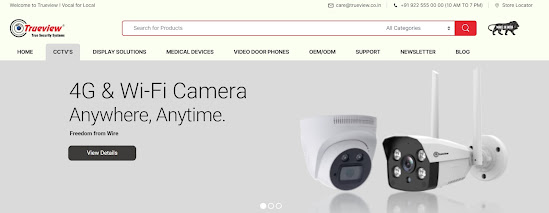How To Choose Best Interactive Display For Education: A Guide
When it comes to choosing the best interactive display for your classroom or education facility, there are a few things you need to take into consideration. In this post, we'll outline what to look for in an interactive display and provide a guide on how to choose the best one for your needs. So, whether you're looking for an affordable option or something more high-end, read on for tips on how to make the right choice.
1. What are interactive displays and what do they offer for the educational sector ?
Interactive displays are essentially large touchscreen monitors that offer a variety of features and benefits for both teachers and students. They provide an interactive and engaging way to deliver content in the classroom and can be used for a variety of purposes, such as lesson planning, presentations, group work, and more. Many interactive displays also come equipped with built-in cameras and microphones, which can be used for distance learning or video conferencing.
2. What factors should you consider when choosing an interactive display?
When it comes to choosing an interactive display, there are a few key factors you need to take into consideration, such as:
- The size of the display. How large of a touchscreen do you need?
- The type of content you'll be displaying. Will you be using it for presentations, videos, web browsing, or something else?
- The features and functions you need. Do you need an integrated camera and microphone for distance learning? Does it need to be compatible with a certain software or app?
- Your budget. How much are you willing to spend on an interactive display?
3. What are the different types of interactive displays ?
There are a few different types of interactive displays on the market, such as:
- All-in-one touchscreen PCs: These come with everything you need in one package, including the computer, monitor, and touchscreen. They're ideal for those who want an all-in-one solution that's easy to set up and use.
- Portable interactive displays: These are ideal for those who need a flexible solution that can be used in different classrooms or even taken on the go. Many portable interactive displays come with built-in stands and can be easily transported from one location to another.
4. How much do interactive displays cost?
The price of an interactive display will vary depending on the size, type, and features you're looking for. In general, you can expect to pay anywhere from $500 to $5,000 for a quality interactive display.
5. Where can I buy an interactive display?
There are a few different places you can buy an interactive display, such as:
- Online: You can find a variety of interactive displays online from retailers like Amazon and Best Buy.
- Local store: You may also be able to find interactive displays at local electronics stores, such as Fry's or B&H Photo.
- Education supplier: If you're looking for an interactive display specifically for the educational sector, you can check out suppliers like School Outfitters or CDWG.
6. What are some of the best interactive displays on the market?
Some of the best interactive displays on the market include:
- Dell 84" Interactive Touch Monitor: This large touchscreen monitor is ideal for those who need a big screen for presentations and group work. It features Full HD resolution, 10-point multi-touch, and an anti-glare display.
- Samsung Flip 2: This portable interactive display is ideal for those who need a flexible solution that can be used in different classrooms or even taken on the go. It features a 55" LED display, 20-point touch capability, and built-in speakers.
- ViewSonic TD2230: This affordable option is great for those who are on a budget but still want a quality interactive display. It features a 22" touchscreen, Full HD resolution, and 10-point multi-touch capability.
7. How do I set up an interactive display?
The specific steps for setting up an interactive display will vary depending on the model you have. However, in general, you'll need to do the following:
- Unpack the display and all of its accessories.
- Follow the instructions in the manual to assemble the stand, if applicable.
- Connect the power cable to the display and plug it into an outlet.
- Turn on the display and follow the on-screen prompts to complete the setup process. This may include calibrating the touchscreen and installing any necessary drivers or software.
8. How do I use an interactive display?
Once you have your interactive display set up, there are a few different ways you can use it:
- As a regular computer monitor: You can use your interactive display just like you would any other computer monitor. This means you can browse the internet, work on documents, and watch videos.
- With touchscreen capabilities: If your display has touchscreen capabilities, you can use it to interact with apps, games, and other software. You can also use it to write or draw directly on the screen.
- With a projector: Many interactive displays come with built-in projectors that allow you to projected images and videos onto the screen. This is ideal for presentations and group work.
9. What are some of the benefits of using an interactive display?
There are a few different benefits of using an interactive display, such as:
- Improved productivity: Interactive displays can help improve productivity by making it easier to collaborate and share information.
- Increased engagement: Touchscreen capabilities and built-in features like projectors can help increase engagement, whether you're using the display for work or education.
- Portability: Many interactive displays are portable, which means they can be easily moved from one location to another. This is ideal for those who need a flexible solution.
Once you've established your budget, it's time to start looking at different features. One of the most important things to consider is the size of the display. If you're planning on using it for large group presentations, you'll need something with a large screen size. Alternatively, if you're looking for something to use in a small classroom setting, a smaller display will suffice.
Another important feature to look for is touch capability. If you want your students to be able to interact with the content on the screen, you'll need an interactive display that supports touch. This is a great way to make learning more engaging and hands-on.
Finally, consider the software that's compatible with the interactive display. Make sure it's compatible with the programs and applications you're using in your classroom or education facility. This way, you can seamlessly integrate it into your existing curriculum.
Now that you know what to look for, it's time to start shopping around for the best interactive display for your needs. Interactive displays can be a great addition to any classroom or education facility. By taking into consideration your budget and needs, you can find the perfect interactive display for your unique situation. So, whether you're looking for an affordable option or something more high-end, read on for tips on how to make the right choice. Happy shopping!




Comments
Post a Comment